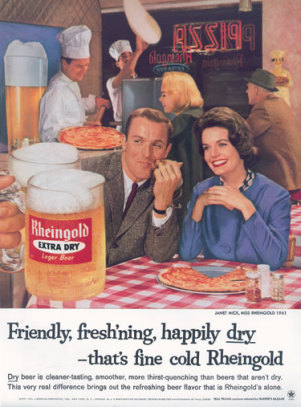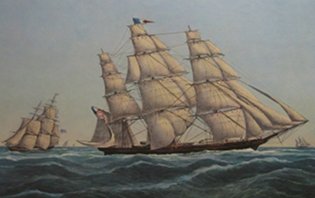A re-post -
 Gourmet pizza nowadays often comes without tomatoes and with all sorts of other toppings, but it was the basic tomato-mozzarella mix that made pizza so popular, beginning in the 1950s, in the US. It was made for beer.
Gourmet pizza nowadays often comes without tomatoes and with all sorts of other toppings, but it was the basic tomato-mozzarella mix that made pizza so popular, beginning in the 1950s, in the US. It was made for beer.
That basic format relied on the importation of the tomato - originally a yellow fruit, the "pomi d'oro," from Mexico to Europe in the 1500s. Cortez brought more than gold to Europe.
From its Greek origins to Chicago's Pizza Uno, the story of pizza is about immigration, entrepreneurialism, and invention. Now, "93 percent of Americans eat pizza at least once a month."
Modern pizza originated in Italy, although the style favored by Americans is more a friend than a relative of the traditional Neapolitan pie. Residents of Naples took the idea of using bread as a blank slate for relishes from the Greeks, whose bakers had been dressing their wares with oils, herbs, and cheese since the time of Plato. The Romans refined the recipe, developing a delicacy known as placenta, a sheet of fine flour topped with cheese and honey and flavored with bay leaves. Neapolitans earned the right to claim pizza as their own by inserting a tomato into the equation. Europeans had long shied away from the New World fruit, fearing it was plump with poison. But the intrepid citizens of Naples discovered the tomato was not only harmless but delicious, particularly when paired with pizza.
Cheese, the crowning ingredient, was not added until 1889, when the Royal Palace commissioned the Neapolitan pizzaiolo Raffaele Esposito to create a pizza in honor of the visiting Queen Margherita. Of the three contenders he created, the Queen strongly preferred a pie swathed in the colors of the Italian flag: red (tomato), green (basil), and white (mozzarella).
Read the whole American Pie at Am. Heritage. 1960s image of Miss Rheingold (a bigger deal in NY than Miss America) from the article. Extra-dry Rheingold Beer - the beer of New York baseball, brewed on the east side of Manhattan until the 1970s.


 Gourmet pizza nowadays often comes without tomatoes and with all sorts of other toppings, but it was the basic tomato-mozzarella mix that made pizza so popular, beginning in the 1950s, in the US. It was made for beer.
Gourmet pizza nowadays often comes without tomatoes and with all sorts of other toppings, but it was the basic tomato-mozzarella mix that made pizza so popular, beginning in the 1950s, in the US. It was made for beer.
Tracked: Feb 09, 09:12